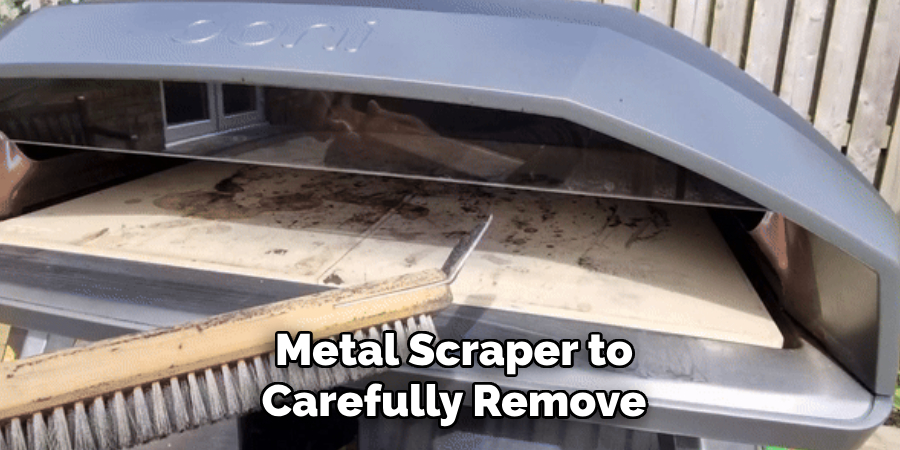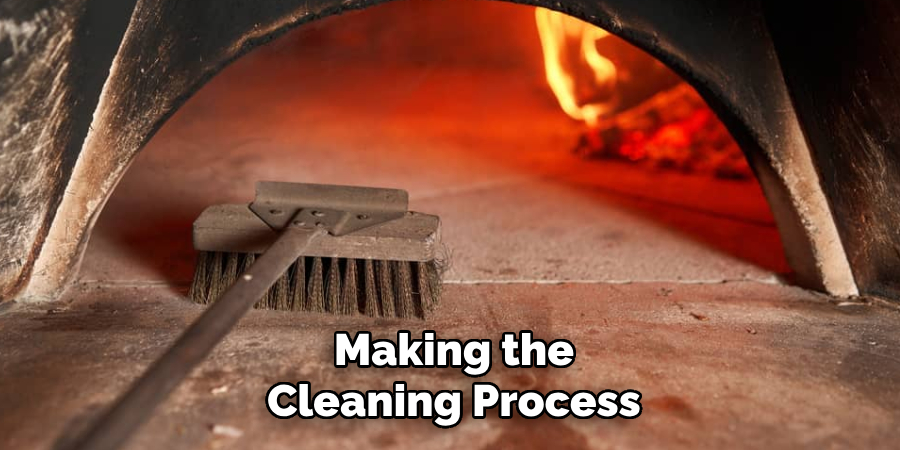Are you tired of constantly cleaning your pizza oven? Well, you’re not alone. Many people struggle with keeping their pizza oven clean and well-maintained.
How to clean a pizza oven is an essential task to maintain its performance, extend its lifespan, and ensure the quality of the food being prepared. Over time, residue, grease, and ash can accumulate inside the oven, potentially affecting how it functions and impacting the flavor of your pizzas. A regular cleaning schedule keeps your oven in top condition and promotes safety by reducing the risk of fire hazards.

Whether you’re using a commercial or home pizza oven, learning the correct cleaning techniques will help you achieve consistent, delicious results while protecting your investment. Let’s dive into the step-by-step process of cleaning a pizza oven.
What Are the Benefits of Cleaning a Pizza Oven?
Before we jump into the cleaning process, it’s essential to understand why regular oven maintenance is crucial. Here are some benefits of keeping your pizza oven clean:
- Maintains the Quality and Flavor of Food: Grease and residue build-up can affect the taste and texture of your pizzas, leading to uneven cooking and an unpleasant dining experience.
- Prevents Fire Hazards: A dirty oven increases the fire risk due to grease buildup and igniting food particles.
- Extends the Lifespan of Your Oven: Regular cleaning prevents damage caused by debris build-up, ensuring your oven lasts for years.
- Saves Time and Money: Regularly cleaning your pizza oven can prevent costly repairs or replacements down the line.
What Will You Need?
To effectively clean your pizza oven, make sure you have the following items on hand:
- Protective Gear: Cleaning a pizza oven can be messy and potentially hazardous. Wear protective gear such as gloves, goggles, and an apron to protect yourself from heat and cleaning products.
- Cleaning Solution: You can purchase a commercial oven cleaner or make your own using baking soda and water.
- Scrubbing Brush: Use a stiff-bristled brush to remove harsh residue and grease build-up.
- Sponge or Cloth: A sponge or cloth will help you wipe down the oven’s interior after scrubbing.
- Bucket of Water: This will be useful for rinsing off the cleaning solution and wiping down the oven.
- Metal Scraper: Use a metal scraper to remove any stuck-on food or debris from the oven walls and floor.
- Paper Towels: Keep some paper towels handy to dry off the oven after cleaning.
Once you have all the necessary supplies, it’s time to start cleaning your pizza oven!
9 Easy Steps on How to Clean a Pizza Oven
Step 1: Remove Loose Debris
Before starting the cleaning process, begin by ensuring the pizza oven has completely cooled down. Use a stiff-bristled brush or a metal scraper to carefully remove any loose debris, such as ash, crust remnants, or burnt food particles from the floor and walls of the oven.

If your oven has removable components, such as racks or trays, take them out and clean them separately. Start by shaking off crumbs or burnt food before soaking them in warm, soapy water to loosen any grease or stuck-on residue. Removing loose debris will make focusing on the tougher build-up easier in the following steps. Be thorough during this step, as a clean slate will lead to a more effective cleaning process as you continue.
Step 2: Scrape Off Grease and Baked-On Residue
Once the loose debris has been removed, use a scraper or a stiff brush to tackle any grease and baked-on residue on the oven’s interior surfaces. Apply gentle pressure to avoid damaging the oven’s surface, especially if it is made of brick or delicate materials. Focus on areas with heavy build-up, such as the center of the oven floor or the spots where food tends to burn. Use a damp cloth to wipe away loosened residue as you work. This step ensures a cleaner base for any deeper scrubbing or cleaning agents applied in later steps.
Step 3: Apply a Cleaning Solution
After scraping off most of the residue, apply a suitable cleaning solution to the interior surfaces of the oven. For a natural option, mix baking soda with water to form a paste, or use a commercial oven cleaner for tougher stains. Spread the cleaning solution evenly over the greasy areas and baked-on grime, ensuring complete coverage. Allow the solution for at least 15-20 minutes to break down the remaining residue effectively. This step prepares the surface for the final scrub, making the cleaning process more efficient.

Step 4: Scrub and Wipe Down
Once the cleaning solution has had time to work, use a non-abrasive scrubber or sponge to scrub away the loosened grime. Focus on stubborn spots, applying gentle pressure to avoid scratching the interior surface of the oven. After scrubbing, use a clean, damp cloth to wipe down all surfaces, removing any remaining residue and traces of the cleaning solution. Rinse the fabric as needed to ensure a thorough wipe-down. This step leaves your oven looking refreshed and ready for use.
Step 5: Reassemble and Test
After ensuring the oven is completely clean and dry, reassemble any removable parts, such as racks or trays, and place them back in their appropriate positions. Before using the oven, turn it on at a low temperature for a few minutes to ensure no cleaning solution residue remains and to eliminate any lingering odors. This final step ensures your oven is thoroughly cleaned, safe to use, and ready for your next cooking adventure.

Step 6: Maintain Regular Cleaning
To keep your oven in excellent condition and reduce the buildup of grease and grime, it’s essential to establish a routine cleaning schedule. Wipe down spills and splatters as soon as the oven has cooled after each use to prevent stubborn stains from forming. Consider using a damp cloth or sponge with a mild cleaning solution for regular maintenance, avoiding abrasive tools that could damage the oven’s surface. Additionally, a deeper clean every few months will ensure the oven remains efficient and hygienic. By maintaining this regular cleaning habit, you can extend the lifespan of your oven and ensure it consistently delivers optimal cooking performance.
Step 7: Address Minor Repairs Promptly
If you notice any minor issues with your oven, such as a loose handle, a malfunctioning light, or uneven heating, address these problems as soon as possible. Ignoring minor repairs can lead to more significant issues over time, potentially affecting the performance and safety of your oven. Consult the oven’s manual for troubleshooting tips or contact a professional technician. Prompt attention to repairs will extend the lifespan of your oven and ensure it continues to function correctly.
Step 8: Perform Periodic Inspections
Conduct periodic inspections of your oven to ensure all components are working correctly. Check the door seal for any signs of wear or tears, as a damaged seal can cause heat to escape, reducing efficiency. Inspect burners, racks, and thermostats to confirm they function as intended. Regular inspections help identify potential issues early, allowing for timely intervention to maintain your oven’s performance and safety.
Step 9: Ensure Safe Use
Using your oven safely is essential to prevent accidents and maintain your appliance in good condition. Always follow the manufacturer’s guidelines and safety instructions when operating your oven. Avoid using the oven to heat your home, as this can lead to carbon monoxide buildup or excessive wear on the appliance.
Keep flammable materials, such as paper towels, oven mitts, or plastic containers, away from hot surfaces and open flames. Never leave your oven unattended while it is in use, particularly when broiling or using high heat settings, as this increases the risk of fires. Teach household members proper oven safety practices, including the use of oven mitts to handle hot dishes and the importance of turning off the oven after use.

By following these steps and establishing good cleaning and maintenance habits, you can ensure your oven remains a reliable and efficient cooking appliance for years.
5 Things You Should Avoid
- Using Excessive Water: Avoid using large amounts of water, as it can damage the oven’s components and take a long time to dry, potentially causing rust or electrical issues.
- Scrubbing with Harsh Abrasives: Avoid using steel wool or other harsh scouring tools that can scratch and damage the oven’s interior surfaces, especially if made of stone or coated with non-stick materials.
- Skipping the Cool-Down Period: Never start cleaning the oven while it’s hot. Allow it to cool completely to avoid burns and potential damage to cleaning tools.
- Using Strong Chemicals: Avoid heavy-duty chemicals or cleaners that could leave residue or fumes, as this may affect the flavor of food cooked in the oven later.
- Neglecting Regular Maintenance: Avoid waiting too long between cleanings, as built-up grease and food debris can become challenging to remove and may lead to safety hazards or decreased oven performance.
Conclusion
How to clean a pizza oven doesn’t have to be a daunting task if approached with care and regular maintenance.
By following proper cleaning techniques, such as brushing away debris, wiping down surfaces, and avoiding harsh chemicals or abrasives, you can ensure your pizza oven remains in excellent condition for years. Always prioritize safety by allowing the stove to cool before cleaning, and promptly address messes after use.
A well-maintained oven enhances its lifespan and ensures optimal cooking performance and delicious results every time.
Professional Focus
Angela Ervin, a former interior designer turned blogger, specializes in kitchen design and renovations. Through her website, she blends her passion for cooking with design expertise, sharing practical and creative ideas. Known for balancing functionality and beauty, Angela’s insightful content has made her a trusted voice in home design and lifestyle.
About the Author
Angela Ervin, an experienced interior designer and blogger, combines her passion for kitchen renovations with storytelling. Living in Petersburg with her family, she enjoys cooking and testing her projects firsthand. Known for her humor and relatable style, Angela shares creative, functional design insights through her content, making her a trusted voice in home design.
Education History
University: Virginia Commonwealth University
Degree: Bachelor of Fine Arts (BFA) in Interior Design
- Angela’s education at VCU focused on mastering core interior design principles, including spatial planning, color theory, materials selection, and sustainable design practices.
- She gained hands-on experience through studio projects and collaborative design exercises, which honed her ability to create functional and aesthetically pleasing environments.
- Her coursework also emphasized problem-solving and practical applications of design, preparing her for real-world projects like her self-directed kitchen renovations.
- The program’s strong foundation in both technical skills and creative expression shaped Angela’s ability to seamlessly integrate form and function in her work.
